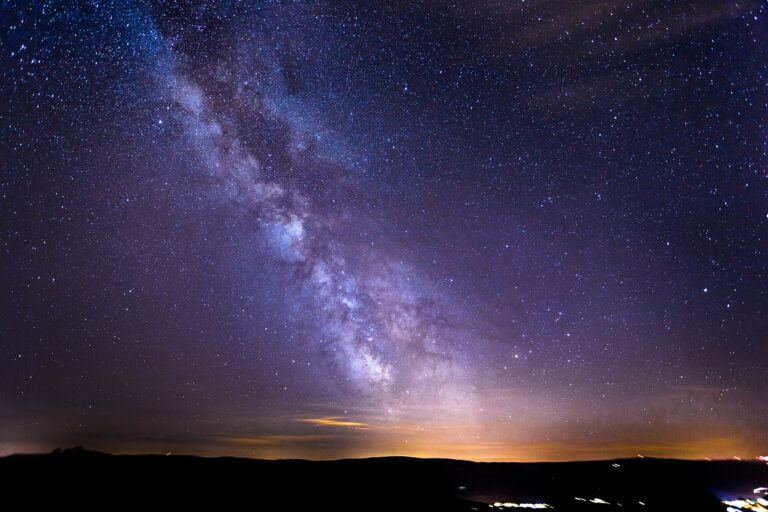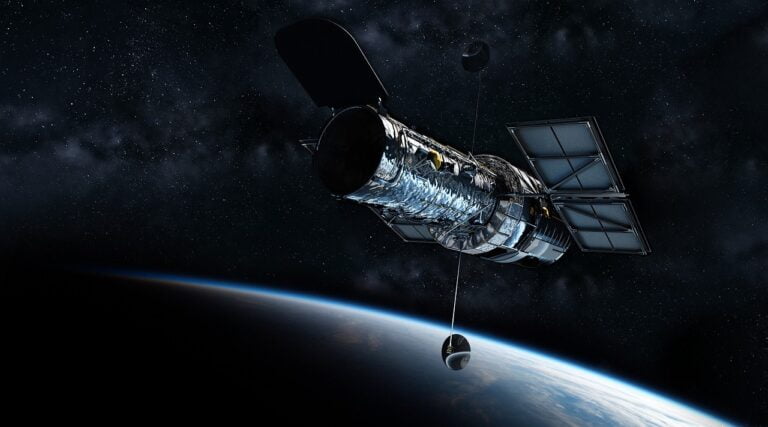The Milky Way : A Journey Through Time and Space

Introduction:
The Milky Way galaxy is our celestial home. It has captured the imagination of humanity for centuries. The Milky Way stands as a beacon of wonder and mystery. From ancient myths to modern science fiction. It is a tale of cosmic proportions that continues to captivate astronomers and enthusiasts alike. Its vastness and mystery continue to fascinate us. Let’s embark on this journey through time and space, uncovering the mysteries of our galaxy’s revelation.
Origins: Birth of a Galaxy
Our story begins approximately 13.6 billion years ago in the aftermath of the Big Bang. Amidst the chaos of cosmic creation a tiny fluctuations in density gave rise to regions of greater concentration (the seeds of galaxies).The Milky Way emerged from this primordial soup. which gradually coalescing from gas and dust into a majestic spiral structure. The Milky Way emerged as a swirling mass of gas and dust. which is destined to become our celestial home.
Early Evolution: Shaping the Galactic Landscape (Approximately 13 to 12 Billion Years Ago)
In the early epochs of its existence.The Milky Way underwent a period of rapid evolution. Gravity Attract together vast clouds of primordial gas. which giving rise to the first generation of stars. These massive stellar furnaces blazed to life. which are illuminating the cosmic darkness and seeding the galaxy with heavy elements. which all are essential for the formation of future generations of stars and planets.
Stellar Birth and Expansion: A Flourishing Galaxy (Approximately 12 to 10 Billion Years Ago)
As millennia passed. The Milky Way continued to evolve with star formation accelerating within its spiraling arms. Massive star clusters burst into existence. which are illuminating the galactic landscape with their brilliance. Supernovae explosions scattered heavy elements across the cosmos. Resulting in the galactic environment and paving the way for the emergence of life-sustaining planets.
Stable State: A Mature Galaxy (Approximately 10 Billion Years Ago to Present)
By around 10 billion years ago. The Milky Way had reached a relatively stable state. Its spiral arms firmly established and star formation proceeding at a steady pace. Over time, smaller galaxies were drawn into its gravitational embrace. which contributing to its growth and evolution. Today, the Milky Way stands as a majestic tapestry of stars, planets and interstellar matter. A testament to the enduring forces of gravity and cosmic evolution.
Evolution: Shaping the Milky Way
As eons passed, the Milky Way underwent a series of transformative events. which sculpting its form and character. Collisions with other galaxies and mergers with smaller companions. which continuous pull of gravity shaped its spiral arms and galactic bulge. These dynamic processes are captured in real-time by astronomers. Its highlight the ongoing evolution of our cosmic home.
The Early Observations: Antiquity to the Renaissance (200 BCE – 1600 CE)
Ancient civilizations gazing up at the night sky. They pondering about the celestial mysteries. Early astronomers like Hipparchus and Ptolemy documented vague band-like structures in the sky. which are hinting at the presence of our Milky Way. Fast forward to the Renaissance era. where Galileo Galilei’s invention of the telescope revolutionized celestial observation. In 1609, Galileo’s telescopic observations. Provided the first clear evidence that the Milky Way was composed of countless individual stars. Its forever changing our perception of the cosmos.
The Great Debate: Early 20th Century (1920s)
As astronomy advanced into the 20th century. Scientists grappled with the true nature of the Milky Way. The “Great Debate” of the 1920s pitted astronomers Harlow Shapley and Heber Curtis. Both are against each other in a lively discussion about the size and structure of the Milky Way. which are Shapley, using observations of globular clusters. They argued that the Milky Way was much larger than previously thought. It placing the Sun far from its center. Curtis, on the other hand. He favored a smaller Milky Way with the Sun near its center. This debate sparked further research and ultimately led to a deeper understanding of our galaxy’s structure.
Radio Astronomy: Mid-20th Century (1930s – 1950s)
The advent of radio astronomy in the mid-20th century. They opened new windows to explore the Milky Way. In the 1930s, Karl Jansky’s discovery of cosmic radio waves. which laid the foundation for radio astronomy as a powerful tool for studying galaxies. In the 1950s, astronomers like Grote Reber used radio telescopes. To map the distribution of neutral hydrogen gas in the Milky Way. which are used to revealing its spiral structure. These groundbreaking observations provided crucial insights into the dynamic nature of our galaxy.
1904: Harlow Shapley’s Galactic Center Determination
In 1904, Harlow Shapley an American astronomer. Harlow made a groundbreaking discovery by determining the position of the Milky Way’s galactic center. Through careful observation of globular clusters. By Shapley deduced that the center of our galaxy lies far from the Earth’s position. Fundamentally altering our understanding of the Milky Way’s structure and scale.
1951: Discovery of the 21-centimeter Hydrogen Line
In 1951, astronomers Edward Mills Purcell and Harold Ewen. Both are detected the 21-centimeter hydrogen line. A key spectral signature emitted by neutral hydrogen atoms. This discovery revolutionized our ability to map the Milky Way’s distribution of hydrogen gas. which are providing crucial insights into its structure and dynamics. It laid the foundation for future radio astronomy observations of our galaxy.
1985: COBE’s Cosmic Microwave Background Observations
The Cosmic Background Explorer (COBE) is launched by NASA in 1989.Its made groundbreaking observations of the cosmic microwave background radiation. These observations revealed fluctuations in the background radiation. which is offering evidence for the seeds of structure formation in the early universe. COBE’s findings provided important clues about the formation and evolution of galaxies. Its including our own Milky Way.

1990: Hubble’s Deep Field Observations
In 1995, The Hubble Space Telescope captured the iconic Hubble Deep Field image. which is revealing thousands of distant galaxies in a tiny patch of sky. Subsequent observations are including the Hubble Ultra-Deep Field and the Hubble extreme Deep Field. Further expanded our understanding of galaxy formation and evolution. These deep field observations offered insights into the Milky Way’s place in the cosmic web of galaxies.
Modern Era: 21st Century (2000s – Present)
In the 21st century, Technological advancements have propelled our understanding of the Milky Way to new heights. Space telescopes like the Hubble Space Telescope and the Gaia spacecraft have provided unprecedented views of our galaxy’s structure and composition. Collaborative efforts between international space agencies. which are including NASA and the European Space Agency (ESA).They have yielded detailed maps of the Milky Way and its stellar populations. These modern discoveries continue to shape our understanding of the Milky Way’s. Its origins, evolution and future.
2009: Kepler’s Exoplanet Discoveries
NASA’s Kepler Space Telescope launched in 2009.which is revolutionized our understanding of exoplanets beyond our solar system. Kepler’s observations identified thousands of exoplanet candidates. It including rocky planets within the habitable zones of their host stars. These discoveries provided tantalizing clues about the prevalence of Earth-like worlds within the Milky Way. It is sparking speculation about the potential for extraterrestrial life.
2013: Gaia’s Stellar Census
The European Space Agency’s Gaia mission. which is launched in 2013.Its embarked on a mission to create a precise 3D map of the Milky Way galaxy. Gaia’s observations have cataloged the positions, distances and motions of over a billion stars. which are providing astronomers with unprecedented insights into the structure and dynamics of our galactic home. Its data has been instrumental in studying the Milky Way’s history, evolution and future trajectory.
Current State: A Snapshot of the Milky Way Today
Today, the Milky Way stands as a vast tapestry of stars, planets and interstellar matter. which is stretching over 100,000 light-years from end to end. Our solar system resides within one of its spiral arms. which are nestled among billions of neighboring stars. By Using Cutting-edge research, including data from space telescopes and ground-based observatories. They provides unprecedented insights into the Milky Way’s structure and dynamics.
Future Prospects:
Just as the birth of the Milky Way captivates our imagination. so too does its eventual demise. In billions of years, it will face the prospect of colliding with the neighboring Andromeda galaxy, an event that will reshape both galaxies and their stellar populations. Beyond this merger, the fate of the Milky Way is uncertain. Along with possibilities ranging from eventual dissolution to absorption by a larger galactic neighbor.
The Andromeda Collision: Future Merger (Approximately 4 Billion Years in the Future)
One of the most anticipated events in the Milky Way’s future is its collision with the Andromeda galaxy. Approximately 4 billion years from now, The gravitational dance between these two cosmic giants will culminate in a dramatic merger. This cosmic collision will reshape both galaxies. Its triggering a burst of new star formation and altering the galactic landscape forever.
Galactic Cannibalism: Absorption by a Larger Galaxy (TBD)
Beyond the Andromeda collision. The Milky Way may face the prospect of galactic cannibalism. where it is absorbed by a larger neighboring galaxy. Such encounters are common in the universe with larger galaxies consuming their smaller counterparts. While the exact timing of such an event is uncertain. while simulations suggest that it could occur billions of years in the future. This process is gradual. It would ultimately spell the end for our galactic home.
Heat Death of the Universe: End of Cosmic Evolution (TBD)
In the distant future. The Milky Way’s demise may be overshadowed by the ultimate fate of the universe itself. According to current cosmological models. The universe is destined for a state of heat death. where entropy reaches its maximum and all energy dissipates. In this scenario, stars will exhaust their fuel. Galaxies will fade into darkness and the universe will become a cold leads. While the timeline for this cosmic fate is uncertain. It represents the ultimate end of all things.
The Milky Way Tomorrow:
As we gaze towards the future. The Milky Way continues to hold mysteries yet to be unraveled. From the fate of our own solar system to the eventual collision with the Andromeda galaxy billions of years from now. The Milky Way’s story is far from over. Emerging technologies and innovative research methods promise to unveil new discoveries and deepen our understanding of our galactic home.